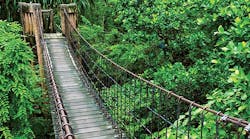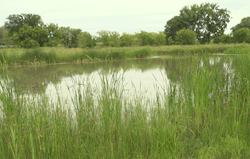Environmental Protection: Bridge Building Boosts Habitats
Working closely with nongovernmental organizations (NGOs) is helping operating companies including Dow, Neste, Solvay and BP improve or protect the condition of areas adjacent to their sites.
Dow, for example, has just marked ten years of collaboration with The Nature Conservancy (TNC), Arlington, Va. The company’s riverside wetlands project adjacent to the production complex at its headquarters in Midland, Mich., points up the benefits of such relationships.
The 23-acre conservation wetland along a stretch of the Tittabawassee river was prone to flooding. The site, first constructed in the 1940s to cool water from a coal-fired power plant (a role that lasted for the next 40 years), had accumulated about 90,000 cubic yards of ash.
An earthen berm constructed of sand and silt surrounded the site, which hydraulically connected to the adjacent river. Dow’s original plan was for capping and long-term maintenance including groundwater treatment and monitoring.
However, Dow in conjunction with TNC assessed different ecosystem services and cost/benefit analyses using a specialized modeling tool called Ecosystem Services Identification and Inventory (ESII) and came up with a better option for the site (Figure 1).
“The results of the alternative evaluation demonstrated that an enhanced restoration including a vegetated stormwater wetland delivered higher level of ecosystem services than the traditional conclusion. A further economic study showed that the enhanced restoration option reduced upfront costs and operations and maintenance when compared to the traditional capped option, resulting in savings of $2 million in net present value,” explains Todd Guidry, Houston-based civil engineering operations leader and co-lead of Dow’s Valuing Nature goal. (That goal commits Dow to finding $1 billion in value by 2025 from projects that are good for business and better for ecosystems.)
“This project presented two major learnings. The first was that we’re going to have to challenge the status quo to implement projects that are good for business and better for nature. The second is that we need more tools to support decision-making on projects that incorporate nature-based solutions,” adds Guidry.
Figure 1. Work with an environmental group lead to an alternative strategy to deal with an old ash pond. Source: Dow.
More Projects
Plans to return a large tract of land at Dow Chemical Canada’s Fort Saskatchewan, Alberta, site to natural habitat and grazing are still in development. “One of the things we’ve encountered on land management change or transaction projects is that they take time…typically a few years. We’ve experienced this in [the] Fort Saskatchewan property as well as other land projects we have in the pipeline,” he notes.
A project based on phytoremediation (the use of green plants to treat pollutants) at the company’s site in Terneuzen, The Netherlands, is further along. A plot of land there includes approximately 250 poplar trees and sheep replacing traditional mowing to reduce maintenance costs.
One specific area of conservation focus for Dow is building coastal resilience in the regions and communities where it operates. As an example, in December last year, the company collaborated with TNC and the U.S. Army Corps of Engineers to facilitate a workshop sponsored by the Texas Chemistry Council on nature-based solutions for building resiliency along the Texas Gulf Coast.
The three-day workshop attracted more than 30 governmental, non-governmental, academic, regulatory and industrial organizations, says Guidry. Topics presented included climate change impacts specific to the region and nature-based-project case studies.
Meanwhile, half-day workshops with TNC at Dow’s Fort Saskatchewan site identified opportunities such as using a stormwater wetland to address some site flooding issues. The company now is assessing the merits of the various ideas.
“One of the more exciting evolutions of the Nature Goal occurred in 2020 and was specifically related to our workshops. With Covid travel restrictions in place, traditional workshops were not an option so we decided to make the transition to virtual delivery. For 2020, our target region for the goal was Asia Pacific. Virtual delivery turned out to be much more successful than anticipated as we were able to expand our original footprint, and attendance also significantly increased. We ultimately were able to engage sites in China, Indonesia, Japan, Korea and Thailand, and identified more than 40 projects from the region,” explains Guidry.
“These ongoing efforts have so far saved the company over $500 million in net present value through projects that are good for business and better for the environment — so the business case is there,” Guidry stresses. “We’re not in this alone. Nature has no fence line and neither should we. We need to work together to address the issues of our time. We need to challenge the status quo within our sphere of influence to fit seamlessly into nature and bring nature to the design table,” he concludes.
Accelerating Activities
In 2019 Neste, Espoo, Finland, established an external independent Advisory Council on Sustainability and New Markets, headed by John Elkington, chairman of environmental think tank and advisory firm Volans, London. The council’s goal is to help Neste accelerate and extend its ongoing sustainability activities.
“We work together with NGOs on different levels,” notes Salla Ahonen, Neste’s vice president, sustainability. “At the strategic level, we use NGOs and other organizations as sounding boards, for example when finalizing our materials assessment or climate strategy. The next level considers how we work together with such organizations in practical issues, for example with projects related to sustainability in the supply chain. Finally, there is a raising-awareness level, such as organizing voluntary work opportunities for Neste employees or giving donations,” she explains.
As an example of this in action, Ahonen cites the long-term systematic environmental monitoring carried out at the company’s refineries at Porvoo and Naantali in Finland, both located next to preserved and protected waterways and natural habitats (Figure 2).
Figure 2. Company’s two Finnish refineries abut preserved and protected waterways and natural habitats. Source: Neste.
To the west of the Porvoo refinery lies the 75-hectare Stormossen domed bog, which is part of the European Natura 2000 network of nature conservation sites. Stretching over 18% of the European Union’s land area and more than 8% of its marine territory, Natura 2000 is the largest coordinated network of protected areas in the world and offers a haven to Europe’s most valuable and threatened species and habitats.Near the Naantali refinery is the Vanto area of old oak woodland, which is closely monitored because it is one of the last natural habitats of a native beetle. The Svartback nature protection association in collaboration with the University of Turku, Finland, carry out detailed investigations at Vanto.
“Environmental monitoring is included in the requirements of our refineries’ environmental permits and both sites continuously make environmental assessments,” says Ahonen.
Two of the key bioindicators investigated are lichens and mosses. Here, a 36-year collaboration with the universities of Helsinki and Turku has yielded evidence of the recovery in these and other species as emissions to air — especially of sulfur dioxide — have decreased over the years.
“We are now discussing with the two universities about how to further develop biomonitoring and whether or not we could use the same bioindicators to monitor climate change,” mentions Ahonen.
In Indonesia, Neste is involved with a collaborative project involving other global brands such as Unilever, Cargill and Danone, local palm oil companies, as well as NGOs to improve sustainability and reduce deforestation risks in the Siak and Pelalawan regions.
Another is the Consortium of Resource Experts (CORE), itself a collaboration between natural resource management non-profit organization Proforest, Oxford, U.K., and sustainable development consultants Daemeter, Bogor City, West Java, Indonesia. CORE helps Neste continuously manage its deforestation risks not only in its own supply chain but also more widely in the palm oil industry.
“With the help from CORE, we assessed the environmental risks of our company’s palm oil supply chain and prepared an action plan for preventing and mitigating risks. The implementation of the action plan began in early 2017. We also have people on the ground who understand different local environments and their biodiversity and work with smallholders to improve their farming techniques and profitability,” notes Ahonen.
Another collaboration is SUSTAIN Asia, a United Nation’s program to enhance cooperation on sustainable development between organizations in Europe and Southeast Asia. Here, Neste is working with its own suppliers and other chemical companies and their suppliers in the region to share information over blockchain. Ahonen believes that digitalization and its associated technologies will only help further enhance the transparency of Neste’s operations.
“Overall sustainability is about innovation and partnerships and we are always looking for new collaborations,” she concludes.
Biodiversity Focus
In February, Solvay, Brussels, became a member of the Wildlife Habitat Council (WHC), Silver Spring, Md., a move designed to help meet its One Planet goal of reducing pressure on biodiversity by 30% by 2030.
Chief sustainability officer Pascal Chalvon Demersay says that, while the biodiversity goal is a challenging start, still more must be done.
“We have measured our impact on biodiversity by applying lifecycle analysis for our products during their use and end of life. We are at the start of the learning curve, and our membership with the WHC brings localized support to our sustainability network and our sites, particularly those located near sensitive areas, building collaboration for conservation through our commitment to conserve our natural resources. We must take action now,” he explains.
“The WHC provides guidance for Solvay’s own teams to design and implement robust conservation projects which meet WHC conservation certification requirements,” adds senior sustainability officer Mechelle Engemann. This guidance is based on three principles: accessibility, credibility and driving change.
One organization already involved in the certification process is Solvay’s Coatis Global Business Unit, São Paolo, Brazil.
Coatis’s Paulinia site takes up a total area of 16 million m2, 15% of which is occupied by 29 production units, a research-and-innovation center and offices, plus industrial units of seven other companies.
The characteristic vegetation of the region is Atlantic forest and two rivers — the Anhumas and Atibaia — cross the site. The rich fauna includes many species of birds, fish, capybaras, mountain lions, monkeys, rodents, lizards, snakes and other animals.
Examples of the projects and actions related to the biodiversity program include: the reforestation and forest management of native trees; recovery of river banks; the creation of a channel that allows fish to rise in the Atibaia river for breeding purposes; forest preservation to foster mountain lion movement; education projects with the local communities to raise awareness about conservation; and environmental conservation and practices.
The company believes that achieving WHC conservation certification for the site will validate its existing efforts — including for compliance with the ISO 14001 environmental management standard — while identifying potential improvements in biodiversity practices.
“We would also like to become a role model for the chemical sector, showing that it is possible to cohabitate with our production units and nature,” says Ronia Oisiovici, Coatis’ sustainability director.
Currently, the WHC certification project team is mapping the activities at the Paulinia site that positively impact biodiversity to define projects to submit for possible certification.
New Collaboration
In September, BP, London, announced that the company has started a five-year collaboration with conservation charity Fauna & Flora International.
(FFI), Cambridge, U.K. At this point, no joint BP/FFI projects have gotten underway.
Part of the collaboration involves FFI helping BP achieve its net positive impact (NPI) aim as outlined in a new biodiversity position published last June.
In it, BP makes a number of commitments concerning existing and future activities. For example, from 2022 onwards, new BP-operated projects whose planned activities potentially could significantly directly impact biodiversity must develop NPI action plans for those activities.
Also starting next year, the company is putting in place measures that require major operating sites to have plans established to enhance local biodiversity, beginning with sites in biodiversity sensitive areas. Such measures might include restoring wetland habitats, conserving threatened species, or improving the management of protected areas.
The company has identified eight major operating sites with activities inside or adjacent to international protected areas. One is its Lingen, Germany, refinery, which has a water discharge pipeline running under the River Ems Natura 2000 protected area. Similarly, a product pipeline from the Kwinara refinery in Australia lies within 1 km of both the Henderson Park Conservation Park and Kenwick Wetlands Nature Reserve.
Seán Ottewell is Chemical Processing's editor at large. You can email him at [email protected].





